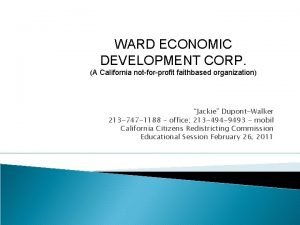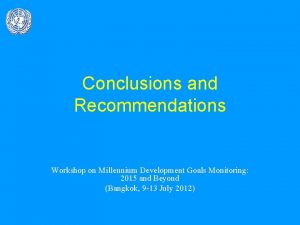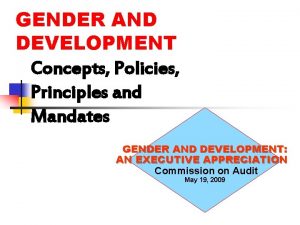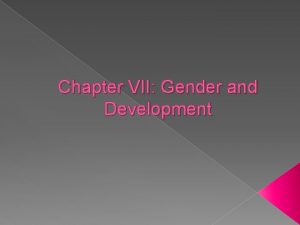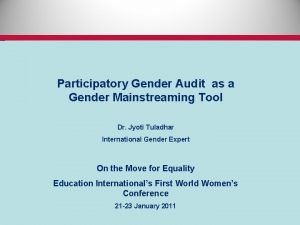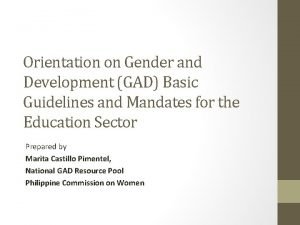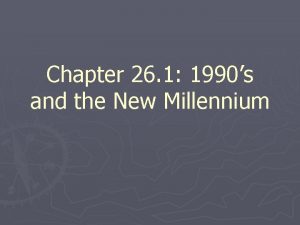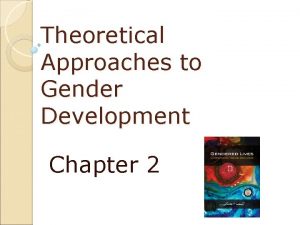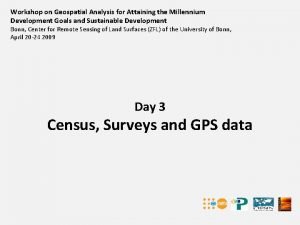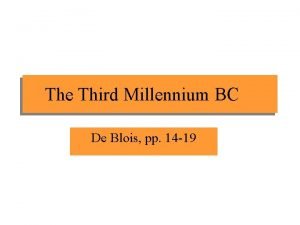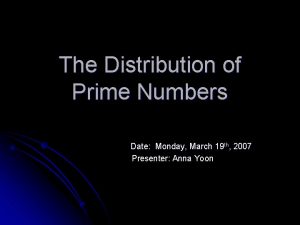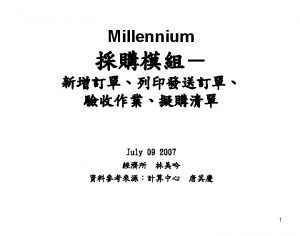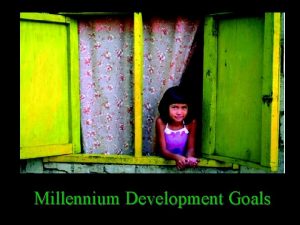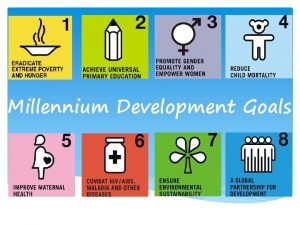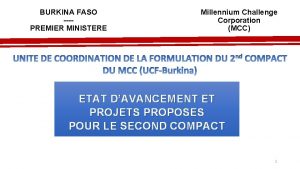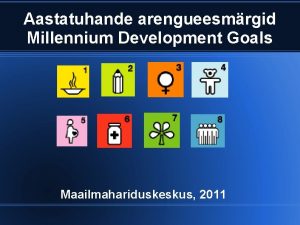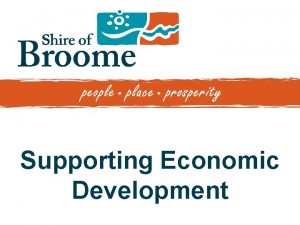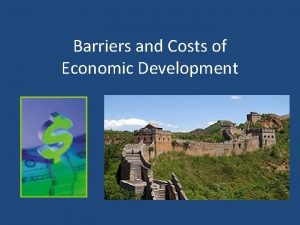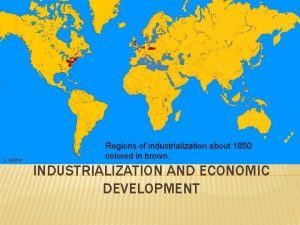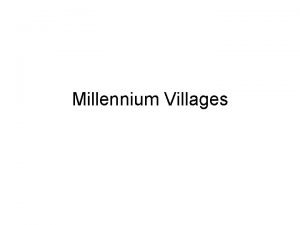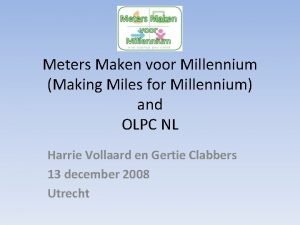Gender and Economic Development in Millennium Challenge Corporation
























- Slides: 24

Gender and Economic Development in Millennium Challenge Corporation Indicators: An Assessment and Recommendations Prepared for the Millennium Challenge Corporation Prepared by Xiaojia (Lydia) Bi, Mariah Quinn Duffy, Bickey Rimal, Kelly Thorngate, and Andrew Trembley

The MIPA Team Lydia Mariah Bickey Kelly Andrew 2

Project Overview • Section I: Gender Equality and Economic Growth – Identify policy instruments of gender equality through relevant scholarship – Review importance for economic growth – Highlight linkages with other policy instruments • Section II: Analysis of MCC’s Current Indicators – Data collection and analysis – Policy access and outcome – Relevance Mariah 3

Project Overview • Section III: Indicator Recommendations – Modifications • • Business Start-Up Land Rights & Access Natural Resource Management Primary Education Expenditures – Additions • • Credit Access Gender-Responsive Budgeting Women’s Health Girls’ Secondary School Enrollment Mariah 4

Project Overview • Presentation Outline – – Recommendation Rationale Description and Data Feasibility Mariah 5

Business Start-Up • Recommendation – Modified existing indicator – Current indicator measures time and cost associated with starting and formally operating a business • Rationale – Gender equality in economic participation and market access likely to contribute to economic growth – Current indicator fails to account for gender inequality in business ownership and operation Bickey 6

Business Start-Up • Description and Data – Retain: current Business Start-Up measures – New Measure: Global Gender Gap Index (GGI) • GGI measures gender differences in economic participation and opportunity • Source: World Economic Forum (WEF) • Feasibility – High – Data published annually – Improves gender-sensitivity Bickey 7

Credit Access • Recommendation – New indicator • Rationale – Capital access vital to business start-up & growth – Female entrepreneurs particularly rely on credit – Female entrepreneurs are constrained in terms access to credit – Current Start-Up indicator assumes high capital access Andrew 8

Credit Access • Description and Data – Measure: domestic credit provided by banking sector • Includes gross credit provided by financial institutions • Not sex-disaggregated • Raises prominence of issue particularly important to women – Source: World Bank – World Development Indicators • Feasibility – High – Regularly measured as part of WDI Andrew 9

Gender-Responsive Budgeting (GRB) • Recommendation – New indicator – Supplement MCC’s existing Fiscal Policy indicator • Rationale – Gender-differentiated needs and priorities ensure resources allocated efficiently – Ensure fundamental equality in health and education – Current MCC macroeconomic indicators not gendersensitive due to reporting mechanisms Lydia 10

Gender-Responsive Budgeting (GRB) • Description and Data – Measure: percentage of parliamentary seats in Single or Lower chamber occupied by women • Women’s political empowerment: precondition for GRB – Source: UN Statistics Division • Feasibility – No international orgs keeping track of all GRB initiatives – Women’s limited political empowerment Lydia 11

Land Rights and Access • Recommendation – Modified existing indicator – Current indicator: • 50% measures rural land use • 50% measures peri-urban land use (for business) • Rationale – Increase in household wealth & business/agricultural investment – Currently: equally values very specific peri-urban measures with general measures of land rights Kelly 12

Land Rights and Access • Description and Data – Reweight indicator components • Rural: 75% – Source: International Fund for Agricultural Development (no change) • Peri-urban: 25% – Source: International Finance Corporation (no change) – Rural measures better proxy for general land rights & access – Rural measures likely to become more gender-sensitive • Feasibility – High – Easy to implement with no change in data sources Kelly 13

Natural Resource Management (NRM) • Recommendation – Modified existing indicator – Current indicator considers four measures • Eco-region Protection, Access to Improved Sanitation, Access to Improved Water, Under-5 Child Mortality • Rationale – Women’s different needs and priorities – Better women’s health outcomes – Current MCC indicator not strong in measuring outcomes Lydia 14

Natural Resource Management (NRM) • Description and Data – Retain: eco-region protection, access to improved sanitation, access to improved water – New measure: environmentally-related diseases mortality rate • Infectious and parasitic disease, respiratory infections, COPD • Report separately for men and women • Source: WHO Global Info. Base – New measure: healthy life expectancy at birth • Replace under-5 child mortality rate • Source: UN Statistics Division • Feasibility – High Lydia 15

Women’s Health • Recommendation – New indicator – Supplement MCC’s current health indicators • Rationale – Maternal health services fewer maternal deaths – Reproductive health services lower fertility rates – MCC’s health indicators lack sex-disaggregated data Mariah 16

Women’s Health • Description and Data – Measure: percent births attended by skilled personnel • Measure of maternal health services • Source: UNICEF – Measure: unmet need for family planning • Measure of reproductive health services • Source: UN Population Fund • Feasibility – High – MCC already considers maternal health measure – Both measures tracked by MDG Mariah 17

Primary School Expenditures • Recommendation – Modified existing indicator – Current indicator measures total primary school expenditures • Rationale – Education for girls positively impacts other areas of economic development – Girls’ access to schools improved through specific expenditures Kelly 18

Primary School Expenditures • Description and Data – Retain: total expenditures on primary school – New measure: percentage of teachers who are female • Source: World Bank: World Development Indicators – New measure: transportation provision for education • Source: Country-reported • Feasibility – Moderate • Self-reporting not as reliable Kelly 19

Girls’ Secondary School Enrollment • Recommendation – New indicator – Replace Girls’ Primary Education Completion Rate • Rationale – – Secondary school improved earning potential Secondary school desirable social outcomes Wage & non-wage returns higher at secondary level MCC indicator gender-biased, not gender-sensitive Mariah 20

Girls’ Secondary School Enrollment • Description and Data – Measures: • Girls’ secondary school enrollment rate • Gender parity in secondary school enrollment – Source: UNESCO’s Institute for Statistics • Feasibility – High – Measure already tracked by EFA and MDGs – Unique, only recommendation that moves the bar Mariah 21

Conclusion • Additions – – Credit Access Gender-Responsive Budgeting Women’s Health Girls’ Secondary School Enrollment • Modifications – – Business Start-Up Land Rights & Access Natural Resource Management Primary Education Expenditures Andrew 22

23

24
 Ward economic development corporation
Ward economic development corporation Marine stewardship council
Marine stewardship council Strategic gender needs and practical gender needs
Strategic gender needs and practical gender needs Difference between economic growth and economic development
Difference between economic growth and economic development Economic growth vs economic development
Economic growth vs economic development Conclusion of millennium development goals
Conclusion of millennium development goals Whitchester house
Whitchester house Gender and development concepts
Gender and development concepts Objectives of gender and development
Objectives of gender and development Gender roles and identity
Gender roles and identity Gender and development
Gender and development Sample lesson plan in gender and development
Sample lesson plan in gender and development Chapter 26 section 1 the 1990s and the new millennium
Chapter 26 section 1 the 1990s and the new millennium Ansar financial and development corporation
Ansar financial and development corporation Theoretical approaches to gender development
Theoretical approaches to gender development Chapter 1 lesson 2 our economic choices worksheet answers
Chapter 1 lesson 2 our economic choices worksheet answers Millennium geospatial
Millennium geospatial Third millennium
Third millennium Millennium prize problems
Millennium prize problems Ecosystem assessment
Ecosystem assessment Innopac millennium
Innopac millennium Millennium prize problems
Millennium prize problems Ava fontaine
Ava fontaine Millennium science complex
Millennium science complex Millennium 3 financial services reviews
Millennium 3 financial services reviews
